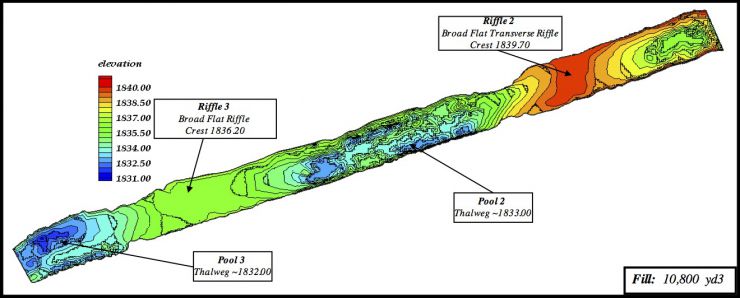TR Design 2
Concept
The concept for Design 2 was to provide two large broad flat riffles with transverse orthogonal crests and accentuated pools, yielding a high riffle-pool relief of 1.58 m and a high asymmetry value of 2.57. The central pool was designed to be large, channel-spanning, and have a lot of submerged features for juvenile rearing and adult holding. The large riffles were designed for Chinook and steelhead spawning. The existing thalweg through the pools was left unmodified. The riffle entrance and exit slopes were graded gradually at ~1%. Even though the overall bed slope was slightly decreased from the baseline value, the local riffle-to-riffle slope was 0.31%. Both local and overall bed slope values were in the 0.2-0.4% range recommended for rehabilitating salmon spawning habitat (Elkins et al., 2007). The riffle-pool spacing in this design was increased from ~5 to 8 channel widths and the variation in channel width between riffles and pools was the lowest of all designs. Design Two was estimated to require 8,257 m3 of gravel and cobble.
Design Map

Design Hypotheses
| Attributes | Riffle 2 | Pool 2 | Riffle 3 | Pool 3 |
| Hydraulic | Transverse riffle placed upstream of existing artificial riffle-weir to avoid high velocities on backside of weir. At riffle exit, constriction promotes flow convergence over subsequent pool. |
Constrictions at pool entrance and pool exit will induce flow convergence, flow acceleration, and eddy formation adjacent to banks.. |
Broad riffle crest with gradual entrance and exit slopes. Gradual pool exit promotes full flow divergence from narrow pool. |
Broad flat riffle will spread flow at depth of ~0.4 ft. Flow convergence at riffle entrance, divergence at riffle exit. |
| Geomorphic | Scour at riffle exit constriction. Higher likelihood of scour on river left than river right of riffle due to flow constriction. |
Pool uses existing contour regime. Focused thalweg and sediment deposition along periphery in eddies will promote pool self-maintenance. |
Constricted pool follows existing contour regime. Constricted pool downstream of broad riffle is conducive to riffle pool maintenance. |
At spawning Q, velocity is below threshold for scour. |
| Fisheries | -Spawning on river left of riffle and on riffle crest. -Increased fry habitat along riffle periphery. |
-Adult holding habitat in pool. -Fry habitat created over channel constriction features. -Spawning on peripheral pool benches. |
-Adult holding habitat in pool. -Spawning on pool benches. |
-Spawning on entire riffle. -Pool-exit rim shape promotes gravel oxygenation and provides good habitat. -Increased fry habitat along riffle periphery |
Design Testing with FESWMS 2D Model
System response was evaluated in terms of flow pattern, fish habitat quality, and sediment transport regime at three discharges within the regulated range permitted by operational rules at the time. At the links below, the results are shown for two of those discharges: (1) a typical baseflow (300 cfs) present during most of the year when fish are spawning and embryos are incubating and (2) the peak regulated flood discharge released by the dam at that time (6000 cfs).
Click links below to see model results:


